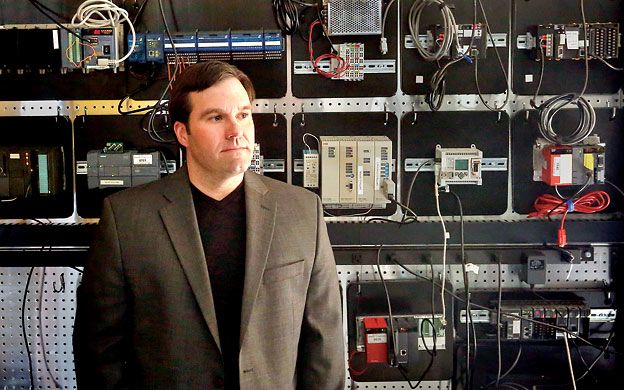Little-known Portland software company Kepware surges in growth
It may be one of Portland's best-kept secrets. Kepware Technologies, which makes software that lets disparate industrial machinery communicate, is quietly tapping the boom in manufacturing, tripling revenue and doubling employees over the past four years. The company also recently appointed a new president.
The reason Kepware isn't readily recognized by its customers is that its software works deep within networks of equipment bearing brands like Rockwell, Siemens and Mitsubishi. But Kepware's software is critical for allowing equipment, old and new, in a network to share information. For example, a 2,700-acre vineyard uses Kepware software to monitor and control its irrigation system, which includes solar-powered flow meters, pumps, alarms and personal computers. Another example is at Arizona State University, where Kepware's software is linking personal computers, monitors, sensors, electrical and other systems in 100 campus buildings with thousands of points that can input data to help that university document and monitor energy use.
“While thousands of people are using it, Kepware's software is 'under the hood,'” explains Craig Resnick, vice president of consulting at ARC Advisory Group, a Dedham, Mass., technology research company. “It's embedded in products such as other people's controllers. The biggest challenge going forward for Kepware is … to get their name in front of the rank-and-file user.”
Those user ranks are growing as companies add more devices to their industrial networks. Research company MarketsandMarkets valued the total market for human machine interface products, which includes both software like Kepware's and hardware like sensors, at $2.5 billion in 2012, and estimated it will reach $4.05 billion in 2017.
Brett Austin, who in mid-January was promoted from CFO to replace Tony Paine as Kepware's president, says his company is addressing $1 billion of that market now with its software products.
“We have the benefit of being in a space where a massive amount of data is being produced, and it's growing every day,” says Austin. “Kepware has the ability with our products to help companies communicate, collect, organize and store that data. If you have a factory with 40 different kinds of hardware, we probably can help you get data out of all those things.”
Resnick of ARC Advisory Group says that with the trend toward more and different types of machines added to networks, Kepware has the potential to be a $100-million-plus company, which would be more than triple its current revenue.
While Austin is focusing on current customers and near-term operations, Paine will remain as CEO, focusing on strategic directions for the company.
“We had a really good run the last 10 years, and certainly accelerated our growth in the last five years,” says Austin. “But we know that what we've done in the last five years won't allow us to succeed in the next five, and so we're continuing to challenge ourselves and to grow the team.”
He adds, “Tony realized he wanted to focus on the strategic vision and building the new technologies we think we're going to need to take us forward over the next five years.”
In the near term, the company will keep focusing on “big data” or the “Internet of things,” terminology for the growing amount of products and data being linked over networks.
“All things are getting connected. A lot of these devices aren't smart,” explains Austin.
In the near term, he says, the company is playing into the trend of how to bring more and more intelligence to all devices, whether they are in a plant, a building or a windmill. Kepware is trying to go beyond a mere connection to a turbine, for example, to also sense whether it is operating correctly and if not, to send a notification through the network so the customer can decide whether to shut it down or perform maintenance.
Rapid growth
With revenues topping $30 million last year, and 20% growth expected this year, Austin points to several factors that are boosting Kepware's growth. One is the oil and gas market, which expands the company's focus to building automation and power distribution applications for customers like Arizona State University. Second is its expansion in non-U.S. markets such as Europe and Asia — almost 50% of company's revenue is international, while less than 1% is from Maine. And finally, over the past few years there's been a trend for manufacturers to “reshore,” or bring some or all of their production back to the United States.
A January 2013 article in The Economist estimated that fewer than 100 firms have reshored manufacturing to the United States, but they include giants General Electric, which moved washing machine, fridge and heater manufacturing to Kentucky from a factory in China, as well as Chinese laptop computer maker Lenovo and Germany's BASF. A Massachusetts Institute of Technology study found 15% of the 108 American manufacturers with international operations that it polled planned to bring some manufacturing back to the United States, whereas one-third were actively considering doing so.
Those moves aren't merely for show. China's labor costs rose more than 7% a year from 2000 to 2008, the magazine noted, while employee pay in advanced economies rose less than 1% annually during the same period. Also figuring in are distance and freight costs to get goods to market.
“The United States has been really strong in manufacturing the last couple years,” Austin says, pointing to the reshoring trend. “That's something we haven't seen in a long time in U.S. production.”
He says decreasing energy costs in the United States, with fracking and natural gas, has made running a U.S. manufacturing facility much more competitive compared to Europe, Asia, China and other markets. Manufacturers also want to be located closer to customers.
“Most manufacturers think that if there's anywhere around a 15% premium to produce in the United States, they are OK with that, because it eliminates the cost of transporting [products] back from Asia,” he says. “That margin was closer to 50% for a while, and that's why we saw so much of the manufacturing go outside of the United States. So there's a great manufacturing renaissance going on, and it's driven a lot by the cost of energy.”
He adds that manufacturing efficiencies in the United States also have contributed to making the country more attractive.
Growing ranks
Austin says that he doesn't know to what degree reshoring has happened in Maine. But with a focus on markets outside the state, the company is benefitting from the surge in factory activity elsewhere.
That translates into a lot of hiring over the past four years, with the headcount doubling to 85 employees, 80 in Portland, one in Shanghai, one in Switzerland, and others elsewhere in the United States. Austin says the company plans to add another 20 people by the end of 2014, a mix of software development, quality assurance, marketing, sales, application engineers and technical education (training and development) people. Over the past year, Kepware has doubled its space to 40,000 square feet by taking a second floor in the building it occupies across from Portland City Hall.
Pulling in talented programmers and other staff isn't easy, but it's doable, says Austin.
“We're proving that you can recruit top talent from all over the world that's willing to look at Maine,” he says.
The company is tapping local universities, like the University of Maine, to offer internships and scholarships that eventually could funnel new employees into the company. Kepware recently donated 36 of its software licenses, worth $36,000, to UMaine so students can familiarize themselves with the software, as well as benefit from its application. It also supports state robotics competitions, with founder Corson “Corky” Ellis serving as a board member of the recently formed Robotics Institute of Maine. And later this month, Kepware plans to donate 25 laptops so that every child in a fourth-grade class at Farrington School in Augusta will have one.
“Up through fifth grade, U.S. students are on par on a global level in math and science, but then we start to fall behind and they lose interest,” says Austin. He adds that laptops and programs like robotics will help drum up interest in science and math again.
Austin also is involved with the group Growing Portland, comprising Tyler Technologies, WEX, CashStar and other companies along with local politicians to grow the local technology work force.
“We are talking about how to grow the tech community, how to brand Portland as a tech place to work and grow a career,” he says. Part of the challenge, he says, is redirecting senior-level executives who relocate to Maine for a new job that doesn't work out. Having a vibrant tech community that offers opportunities to well-credentialed professionals will help that sector grow.
Says Austin,”Hopefully, we're someone you can point to that you can grow a business here, you don't have to move away from Maine, you can recruit here, you can get capital here and you can stay here.”
Read more















Comments